 |
 |
|
 |
 |
 |
 |
 |
| |
 |
| |
 |
| |
The instrumentation used in Cities
of Dream, is very complex. Fabio Armani explores
“mind lands”, painting a strongly and variegated
musical fresco. The tracks richness and complexity, remind
the Mahavisnu Orchestra, the British and German symphonic
rock, the big Indian and North African ensembles, Miles
Davis or Gil Evans experiments.
A rich and unique sound is created by the arrangements
of Fabio, the peculiar usage of samples, the deep programming
sound quest and his love for bold and rhythmic pulsations.
The ensemble is constituted by Fabio
(piano, keyboards and programming), Alessandro
(drums and percussion), Abdullah (ethnic
flutes and percussion), Flavio and Luca
(electric basses), Yasemin, Elisabetta,
Houcine, Noemi, and
Maria Pia (voices), Miguel
(guitars), Marco (saxophones) Carlo
(violin and cello) and Cristiano (violin).
Below you can find some information on the more exotic
instruments used in the CD tracks.
· Nay
· Duduk
· Darbuka
· Req
· Duff
· Zills
· Tablas
· Flamenco Guitar
· Fretless Guitar
· Oud
· Saz
· Santur
|
 |
 |
 |
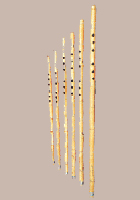 |
| Nay |
|
|
Nay
Traditional Arab flute of different size
used in the classic and popular music. The sound is evocative
and mighty. Abdullah Mohamed plays bamboo
nays that he makes by himself. In Cities of Dreams,
the nay opens the city doors with a sweet and sad recall,
and talks with the intense voices of Yasemine
Sannino and Houcine Ata in an
essential counterpoint. The Abdullah's art, with his flutes,
voices feelings and emotions like love, passion, melting,
joy.
Top
|
 |
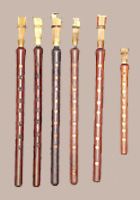 |
| Duduk |
|
|
Duduk
The Duduk has a cylindrical body and a large
reed for a warm, velvety sound, with the qualities of
both an oboe and a bagpipe and soprano sax or clarinet.
The Duduk is capable of producing tones that invoke passion,
celebration, or suffering. The Duduk is of Armenian origin.
Duduks 4000 years old have been found in Egypt and India.
Duduks are often played in pairs. One instrument plays
the melody, while the second plays a tonic drone called
a "dam". The player of the dam is called a damkash,
and s/he uses a special breathing technique to maintain
consistency of tone; this involves inhaling through the
nose and storing air in puffed up cheeks. This is similar
to the technique used by trumpet and bagpipe players.
The Duduk, whether played singly or with a dam, is often
accompanied by a dhol, an Armenian double-sided drum.
Considered by some to be the instrument most capable of
expressing the emotions of the Armenian people. Peter
Gabriel has featured the Duduk in the movies "The
Last Temptation of Christ" and "Us". In
Cities of Dreams the duduk was used in Kam
ma kam where is in wonderful contrapuntist
with the voice of Noemi.
Top
|
 |
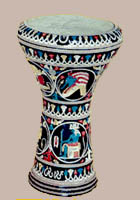 |
| Darbuka |
|
|
Darbuka
Darbuka: the principal soloist Arab percussion.
It has the shape of a broad calyx of 22-23 cm diameter,
made of terra-cotta, wood or metal. The stretched skin,
fish or goat made, is attached to the edge with little
interlaced threads. Abdullah is well-trained in lashing
and carrying away breaking phrases of the darbuka. This
percussion is one of most spectacular instrument of the
soloist percussions family in the world. In God
of Thunder, Abdullah Mohamed
creates, where the sound became more tribal, a exciting
presence with rare precision and effectiveness phrases.
In Kam ma kam, a song of sickening
Arab atmosphere, the darbuka voices the great classic
tradition of Abdullah's music. The sequencers of Beyond
the Dunes introduce the Turkish song of
Yasemine Sannino and the primordial recalls
of Houcine Ata, and the darbuka contributes
to the original, hypnotic sound. In Cities
of Dreams the fast modulation is well played
by Abdalla's darbuka, wonderfully integrated with the
Alessandro D'Aloia drumming, the Fabio
Armani programmed grooves of tablas, udo, african
percussions and more, the Luca Barberini
swinging bass, the hypnotic and mighty sequencers.
Top
|
 |
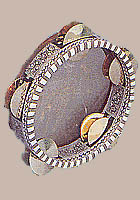 |
| Req |
|
|
Req
Req or Riqq: Arab soloist frame drum. Is a 22 cm diameter
broad frame with a stretched skin. On the same frame there
are two lines of little metallic cymbals. The req is related
with the tambourine, but in opposite to it, with its refined
fingers percussion on the skin, becomes a soloist percussion.
In God of Thunder, Kam
ma kam, Beyond the Dunes
and Cities of Dreams, Abdullah
Mohamed plays a fine dialogue with the darbuka
and the other percussions. The characteristic fills of
the req, played with many different sounds by the Abdullah's
hands, emphasizing his deep knowledge of the Arab musical
culture.
Top
|
 |
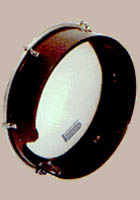 |
| Duff |
|
|
Duff
Duff o Dof: It is an Arab 30-35 cm diameter
broad frame drum used as bass. The duff, as the other
frame drums of the world, is played for the main tempo
with strong and resolute accents. The percussionist plays
the duff with sapient finger hits on the internal and
the external skin and on the wood frame too. The use of
the duff in the Arab music is often reserved to ritual
liturgies with obsessive and hypnotic rhythms. Abdullah
Mohamed plays it in Beyond the Dunes,
Kam ma kam and Cities
of Dreams, integrating the original color
and role of the duff in a contaminated musical context.
Abdullah is a rare musician, master of the Arab music,
with a vision of the "global music" and a clear sensibility
for the "weight" of everyone in an instruments ensemble.
Top
|
 |
 |
| Zills |
|
|
Zills
Zills: Fingers cymbals. Widespread from Far
East to Africa, the zills are little brass made cymbals that
strikes themselves for a pure and mystic but also strong and
percussive sound. In the tradition they are associated with
the dance and played by dancers. The technique used is similar
to the Spanish castanets. The Abdullah's
zills rhythms are appreciated in Cities of Dreams
and Beyond the Dunes.
Top
|
 |
 |
| Tablas |
|
|
Tablas
Tablas: Double Indian Percussion. The Bayan
is the greatest one and has a deep timbre; the Dayan
is smaller and of thinner sound. They are basic elements of
the rich classical Indian music. The rhythmic patterns of
tablas are complex and exciting, and they are studied with
great interest in all the world. Usually the bayan is played
with the left hand the dayan with the right hand. The bayan
gives a regular rhythm, a bourdon, but with smoothing changes
of tuning and expression. The dayan has a wide variety of
sounds: tap, slap, overtones and other percussive effects.
The drums are finely accorded on the tone's harmonics of the
piece played. Fabio Armani is a fan of their
sound and he has programmed exciting and complex tablas parts
in Kam ma kam, Beyond
the Dunes, Love beyond Desert,
Flowers of Sorrow and Dance
for the Moon.
Top
|
 |
 |
| Flamenco Guitar |
|
|
Flamenco Guitar
Flamenco Guitar: Typical intrument of
the Spanish folk tradition, it is a guitar of wide variety
of timbres and expressions. The technique and the soul
of flamenco guitar have been growing during centuries
of history. One thousand of years ago in the area of Mediterranean
Sea, under the Islamic domination, its prototype developed
into the oud in North Africa and the flamenco guitar in
Spain, both instruments voicing the deepness of the poet
who wonders about the human condition. Miguel
Fernandez deeply knows the flamenco and is a
virtuoso of this instrument. In Flower of
Sorrow he dialogues with the piano, playing
in a mood between jazz and contemporary music. The arpeggios
of the first part, the oriental phrases of the second
one, the wonderful block chords under the sax solo, the
rarefied atmosphere that surround the celestial singing
of Elisabetta Antonini, point out the
sensitivity and the technique of Miguel. The warm and
rich timbre of his wonderful instrument is exploited by
the recording fidelity and accuracy. In Beyond
the Dunes, Miguel overdubs various flamenco
guitar tracks, giving that song a peculiar sound, in an
original and complex layer.
Top
|
 |
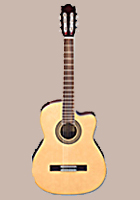 |
| Fretless
Guitar |
|
|
Flamenco Fretless Guitar "Cucculelli"
Flamenco fretless guitar: this is unique model guitar
designed and patented by Argentinean lutist Rodolfo
Cucculelli and by Miguel Fernandez.
The guitar has broad less and hollow frets enabling to
play particularly tuning and glissato. Also Miguel uses
no conventional tuning for the strings, typically to make
lower for most comfortable action and best sound. Miguel
and Rodolfo inspired by the experiences of artist as John
McLaughing and Pat Metheny, have created a guitar able
to recall the oud and the sitar sounds, perfect for multi-ethnic
modern ensembles. Miguel plays this instrument with sensibility
and passion, widening the spirit and the voice of his
polyhedral musical soul. The fretless guitar was used
in Kam ma kam, Beyond
the Dunes and Flowers of Sorrow.
The sophisticate and exciting Miguel performances, let
we travel in wonderful and exotic mind-lands, between
deserts and mosques, passions and sorrows, Earth and sky.
Top
|
 |
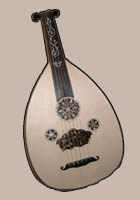 |
| Oud |
|
|
Oud
Oud: it is a lute, direst ancestor of the
European instrument. Made of a chest with the form of an half
almond and a short fretless neck, it is a basic instrument
of classic Arab musical culture. The Arabic people define
it, not without reasons, the "sultan" of musical instruments.
From Arabic world, the oud has spread until the Middle Asia
and the south of Sahara desert, and in the Middle Age it found
its way to Europe through the Spain, brought by the Crusaders.
Oud literarly means "wood", and it is a descendent of a Persian
instrument with four strings called "barbat", used in a pre-islamic
age. The ouds of nowadays have five or six couples of strings
plus a low string. In Beyond the Dunes
is used in conjunction with the Miguel Fernandez
guitars creating a rich and quivering sound and recalling
the feeling of the great Arabic poetry.
Top
|
 |
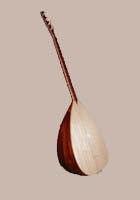 |
| Saz |
|
|
Saz
Saz or Baglama Saz: the name recalls
the eastern roots of this kind of lute. It is characterized
by a long neck on which the doubled strings, usually made
of metal, are bended. This instrument has its origin at
the age of Babilonian and Sumeric culture. Over the centuries
the saz and its variants, as the kogur and the kopuz,
has been used both in the battles and during the mystic
ceremonies of Dervishes. Nowadays the saz is the poetic
soul of Turkish people and is widely spread in all the
Anatolia. We used it in Beyond the Dunes
and Flower of Sorrow, in complex
and exciting arpeggios. The saz create a fascinating effect
of changing and original sounds.
Top
|
 |
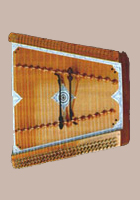 |
| Santur |
|
|
Santur
Santur: is an Iranian stringed instrument. Is a Psaltery
with sound chest and movable bridges under each strings;
each note is generated by a group of three or four chords.
The Santur is played by two little sticks called mezrabs.
The origin of santur go back to the Assyrian and Babylonian
civilizations, that is six centuries B.C. It was imported
in Europe from the Middle East in the XI century, and
after in the 1800 it was introduced in Far Orient from
Europe. We find his predecessors German (Hackbrett), in
France (Tympanon) and England (Dulcimer). In Iran the
Santur reach the perfection: a trapezoidal box with 72
or 100 metallic fixed strings on two line formed by nine
little stands. The normal extension is of three octaves
and the tuning is made for the modal scale performed by
use a key on the screw spikes fixed on one side of the
santur. The player hit the strings with the walnut, or
medlar, or box-wood mezbras that have a end cut for the
better catching with the first three fingers of the hand,
the other end is lightly raised and also, felt covered
sounds like a pianoforte. Fabio Armani
loves the fascination evocated by the santur, and uses
this instrument in the song Cities of Dreams
with others like gamelans and marimbas, to create magic
and dreaming plots.
Top
|
 |
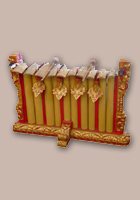 |
| Gamelan |
|
|
Gamelan
Gamelan: is a musical ensemble of Indonesian origin typically
featuring metallophones, xylophones, drums, and gongs.
Traditionally, the term "gamelan" is used to
refer to either the set of instruments making up the ensemble,
or the players of those instruments at any given time.
Gamelan orchestras are common to the islands of Java,
Madura, Bali, and Lombok (and other Sunda Islands) in
Indonesia in a wide variety of ensemble sizes and formations.
In Bali and Lombok today, and in Java through the 18th
century, the term "gong" is or was preferred
to or synonymous with gamelan. Traditions of gamelan have
long been established in Malaysia and Suriname due to
emigration, trade, or diplomacy, and more recently, through
immigration, and local enthusiasm, gamelan ensembles have
become active throughout Europe, The Americas, Asia, and
Australia.
Top
|
 |
 |
| Gong |
|
|
Gong
Gong: is any one of a wide variety of metal percussion
instruments.
The term is Malayu-Javanese in origin but widespread throughout
Asia.
The instrument itself appears to have origins in the bronze
drums of China,
cymbals of central Asia, and perhaps even in European
bell-casting techniques.
Fabio and Alessandro are really enchanted by the possibilities
to create shimmering textures of sounds with these ancient
instruments in their compositions. You can hear examples
of this in the all CD and particularly in
Under Moons of Jade.
Top
|
 |
|
|
|
|
|